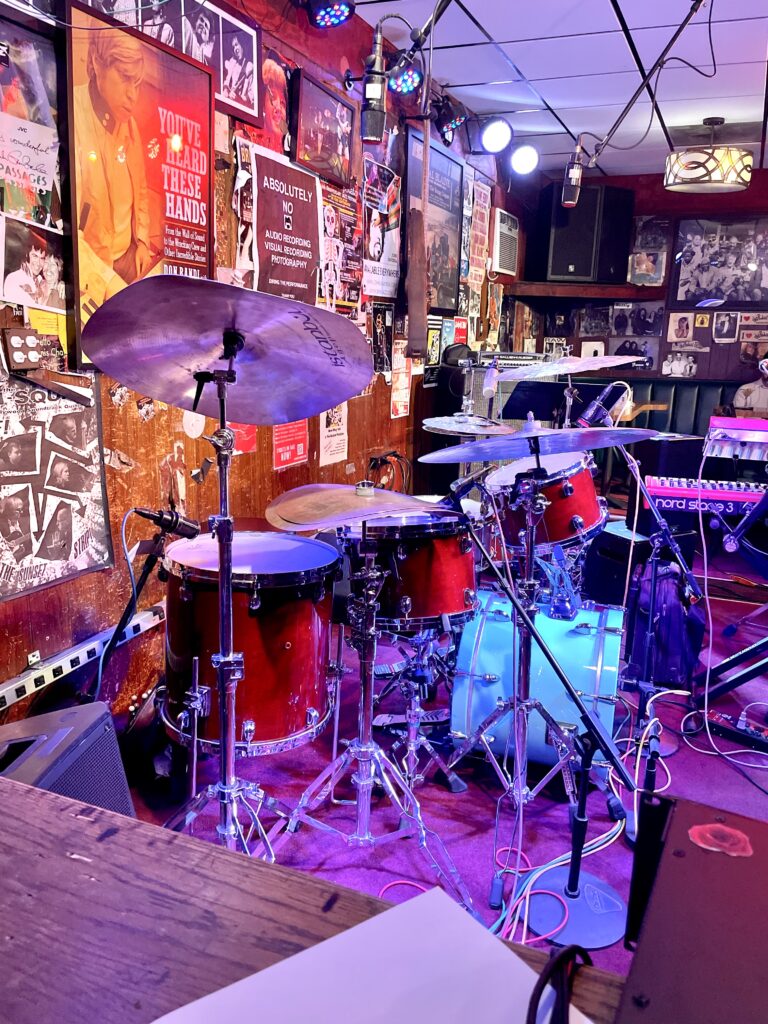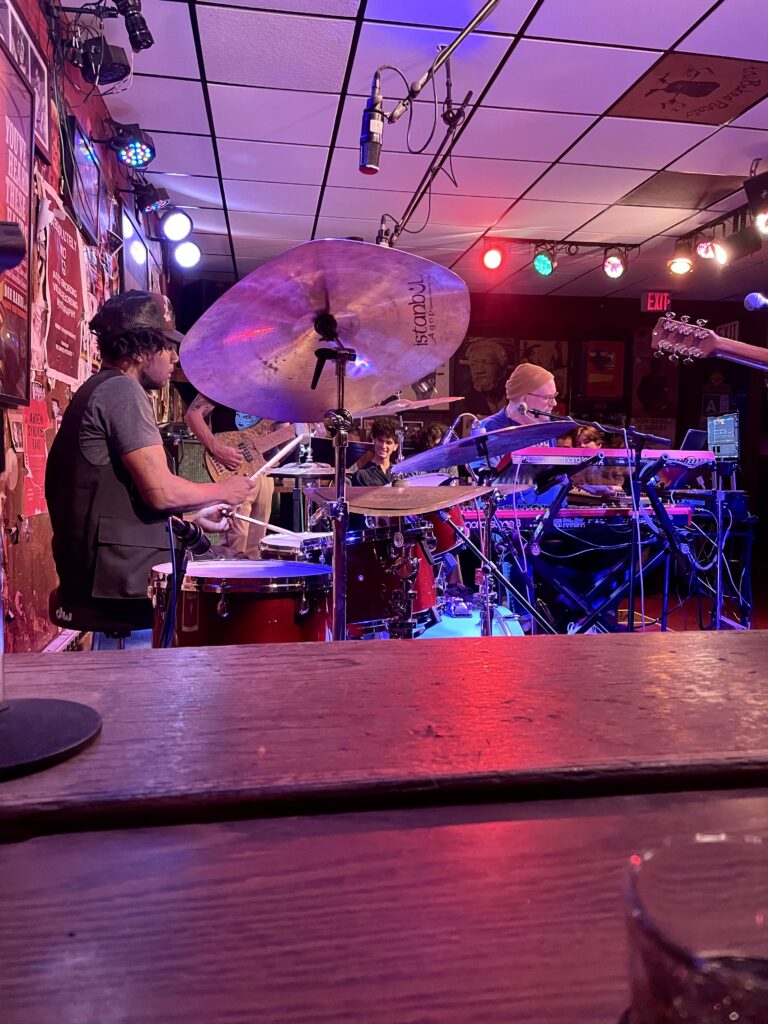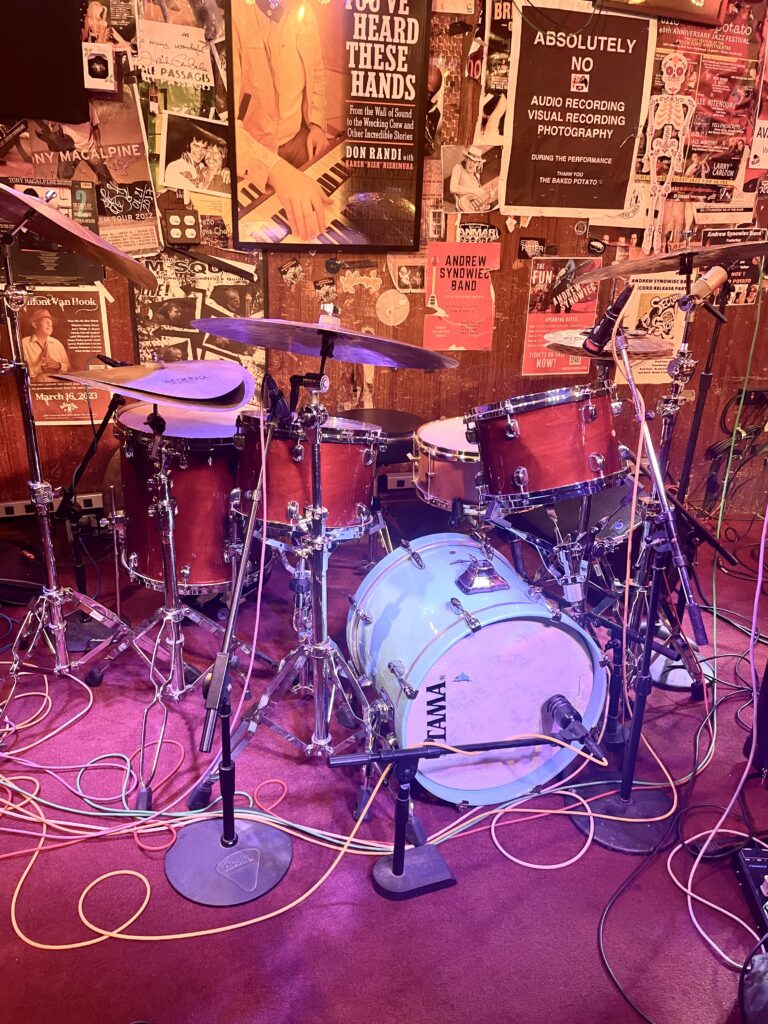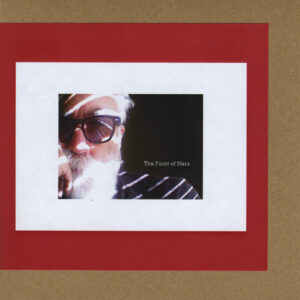
Jazz Is Dead
“Jazz is dead” is really just another way of saying, “They don’t make ’em like they used to.” In that sense, yeah, my condolences. But, of course, that’s exactly the point. The best of the OG jazzmen didn’t make it like they used to from record to record. Evolution is a cycle of birth and rebirth. And all that jazz. Louis Armstrong and his Hot Five, Charlie with Max and the Miles Quintet survive only as sweet memories.
I’m happy to report that jazz—essentially, improvised music—was alive and kicking last night at the The Baked Potato, embodied by keyboardist Scott Kinsey, guitarist Pedro Martins, bassist Francisco Fattoruso and fire-breather Justin Brown on drums.
I’d recently heard both Martins and Brown performing at The Greek Theatre where Martins’ own band opened for headliner, Thundercat. Brown played in both lineups and Martins also sat in with Thundercat, aka Stephen Bruner, for a couple songs. It was the first I’d heard of the young Brazilian guitarist/singer, and I immediately took note. I’d heard buzz of Brown in LA but had yet to hear him live.
His support of Martins’ song-driven set was solid and dazzling, and whatever the hell it was he was doing, beneath a mirrorball helmet, in trio with Bruner and keyboardist Dennis Hamm matched virtuosity and daring with musicality and rocket propellant.
That was an astounding evening of music in the Griffith Park hills, perched high in Section C, and I leapt at the first opportunity to hear Brown in a much more intimate setting.
Local Dive
It doesn’t get much more intimate than The Baked Potato in North Hollywood.
Looking back at the archives, it occurs to me that I’ve never written a “Hittin'” post with this iconic jazz room as the venue. With such a prolific history and deep calendar, the odds of such an omission seem slim.
As it says on the large front-facing lighted yellow sign, just next to the manic dancing spud, the place was “EST 1970”. That’s over 50-years of birth and rebirth, heart and soul, blood and sweat, and the largest baked potatoes you’ve ever seen, currently served 24 unique ways (hotdog and sauerkraut, anyone?).
The tiny interior looks a bit like your creepy uncle’s basement mancave—posters and framed images on the walls, many easily dating back to the 70s, including a large one of Fred Sanford, dimly lit, and old low-pile carpet infused with stale beer.
In a word: Perfection. Just the kind of imperfect, human scaled, lived in, history-imbued space that welcomes you inside and invites you to sit and listen.

The list of world-class musicians who’ve performed here is long, and you immediately feel their collective presence as you walk through the front door directly into the main room.
Aside from some technical tweaks (ceiling mounted mics, for example) and noticeably newly-replaced ceiling tiles (of a modern, asbestos-free variety, I’m guessing), its physical essence hasn’t changed over the years. Same barely elevated stage with two-tiered rows of tables in front, and wall-hugging green vinyl booth seating and tables stage-left.
The adjacent room separates the small bar area and stage-right seating with standing- and seated-height pony walls. The seated table ledge (4-5 available chairs) running the side of the stage is what I deem “drummers’ row,” with the most immediate proximity to the drums…pretty much of any venue, anywhere—reach-out-and-touch-a-cymbal proximity (but, definitely don’t).
So, from high up in section C of The Greek Theater to drummers’ row of The Baked Potato for a dramatically closer look and deeper listen to Brown, Martins and company.
Kin
With those two on the bill—a first, I believe, for a Kinsey-led group—I was kind of hoping for some of what I heard from Martins’ band: Rock/jazz/Brazilian-kissed (some lyrics in Portuguese, no less) song-oriented music, at times evoking an updated, Carioca version of early Pat Metheny Group backing Elliot Smith.
By look of the 5-piece, essentially one-up, two-down, mongrel Tama kit (smallish, compared to the double bass modified Billy Cobham number he plays with Thundercat) on stage, I thought maybe so.
But, this was to be a Kinsey set after all, right down to the pre-recorded background tracks on a couple pieces. As it turned out, fine by me.
This all-instrumental approach (with the exception of a couple songs at the end of the set accompanied by vocalist, Mer Sal) allowed maximum space for the musicians on stage to express, explore and interact on their instruments. These four men did all this brilliantly, holding back and pushing the edges with seasoned musicality, always listening and advancing the whole.
Kinsey watched his bandmates at turn, with a countenance of quiet respect and delight, in between his own adroit flurries for which he’s well known. Fattoruso (Milton Nascimento, Derek Trucks) was masterful at holding things down on his 5-string and swinging for the fences when up to bat.
We were actually sitting closer to Martins than Brown on the outside end of drummers’ row, and it was pure joy hearing his smooth tone and blazing lines while watching his nimble and endowed fingers from arm-length distance.
JB
Just a couple additional arm-lengths behind, wearing a “SUICIDAL THUNDERCAT” trucker cap (a cap I later asked him about and realized now only exists beyond the ether of the internet, or on his head), sat Justin Brown.
Still zipping-up some last-second business on his phone while Martins was beginning the show with a most lovely guitar intro, he soon dialed-in to the moment with some low floor tom grumble and delicate cymbal scrapes before lighting that candle and sending the entire room on an otherworldly ride for the next nearly 120 minutes.
This is what good music can do, of course. Something about a relatively capsule-sized space, precisely, The Baked Potato space, that contributes to that sensation. A sensation that certainly doesn’t occur every time, but there was no doubt that we’d lifted off and were in able hands. Add able feet.

A lot of drummers are fun to watch. For me it has to start with a relaxed drummer. But then, there’s the kinetic motion and physical dance that can mesmerize. I suppose it’s fair to say, at times, that the more motion—the busier the drummer—the more fun it can be to observe. That doesn’t always translate into fun to hear. Especially in the context of improvised ensemble music.
Brown compels the eye. Yeah, he’s fun to watch. His own eyes are usually focused on his instrument—that laser-lock on the ride cymbal or maybe down toward the hat and snare.
Musicians can understand this focus. Sometimes meditating on a simple object with the eyes helps to open the ears. Sure, maybe look up occasionally for a smile or cue, but if it works for Ray Charles, or Joe Morello, who’s to argue (unless you’re playing on Broadway or with Barnum and Bailey!)? Mostly, Brown’s expression is that of total and relaxed concentration.
Like many of my favorite drummers—let’s say Blade, Keltner, or Helm, for example—Brown seems to channel music in a way that’s pretty damn special. Yes, he’s focused, but it’s squarely on the music happening around him, not on what he’s playing or, worse, what he’s about to play.
This manifests in a free-flowing stream of ideas, voicings, and dynamic shifts, while underlying pulse or motion remains unwavering. For example, maybe it’s switching from right hand on hat to ride or floor or tom rim mid-section in a form. Or, maybe moving a backbeat from snare to tight trash cymbals or otherwise mixing and matching within a section.
In less masterful, or more contrived, hands, this can sound jarring; in Brown’s hands and feet it’s seamless, organic and compelling, translating as moving scenery while traveling at a steady pace…perhaps just outside that round spaceship window!
He’s not a simple drummer. Cheers, Levon. But, he never seems busy for busy’s sake—a real pitfall for many technical drummers. As technique should, I submit, his seems only to serve how he hears music in his head and manifests it on the instrument.
Inner notes abound. Rhythms can be broken yet flowing, or halting and jagged. Indeed, that look of Kinsey’s—the one of respect and delight—would come Brown’s direction when he’d occasionally add an intentional bump in the road, rhythmically.
Sometimes bumps are just bumps—contact-your-city-councilman kind of bumps; and sometimes they’re delightful, maybe rollercoaster kind of bumps. And sometimes, I suppose, they’re just the natural way of things, like the back of an alligator. Brown’s bumps are of the last two varieties. Again, in less dependable hands, you can find your councilman online.
Overall, Brown’s drumming—and this struck me even way up in Section C—is wholly singular and electrifying. But more, up close, he seems to me one of those generational drummers that change shit. I have my personal list of these throughout the short history of the drum set, and I can tell you it’s a short list.
Broad influence—changing the game—has much to do with how many people are exposed and listening (certainly not how many are voting in a magazine poll), but for those paying attention, Brown is among the transformational drummers of his generation. I say this well aware of the pitfall—over-busy drummers and hyperbolic opinions—and I express it with full acknowledgment.
In fact, we had an enjoyable talk after the first set and the very first thing I said to him was, “That was like seeing Tony in ’63.” He instantly, viscerally both appreciated and rejected the notion at once.
I meant it. Hearing and watching him play, at some point it occurred to me that the experience of witnessing the levels of transcendence, intensity, excitement and innovation coming from behind the drums must’ve felt similar for drummers watching Tony for the first time at, let’s say, The Plugged Nickel in Chicago—taking Miles, Wayne, Herbie and Ron out of the equation, of course.
There you have it, Justin. Sorry.
Rock ‘N’ Roll Will Never Die
As sayings go, why is it “Jazz is Dead” and “Rock n Roll will never die”? I’ll take a crack at it. Jazz is dead because for those who bemoan the inevitable change of the “jazz” they loved, well, 1) Yes, it’s dead and 2) Of course, it’s dead. The saying comes of sentimentality and pessimism.
Rock ‘n’ Roll will never die, on the other hand, because the spirit of young people doing something new and exciting and breaking rules along the way lives on regardless of its generation and time, and whatever comes of it.
It’s an unquantifiable boon for jazz (improvised music, generally) and jazz musicians that rock music was born and reborn many times over now.
It runs thorough the veins of the new breed of players and informs whatever’s next. Hint: Something new is always next. Did I mention that both Bruner brothers, Stephen and heavyweight drummer, Ronald Jr., played with Suicidal Tendencies (hence the hat!) and that Mike and Dean of ST came onstage to play a couple songs with Thundercat at The Greek?
So, it can’t be both. If Rock n Roll Never Dies (it doesn’t), then Jazz Isn’t Dead (it’s not). And luckily, for all of us, those old records we love should be around for a good long while to come.







